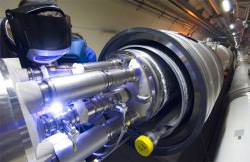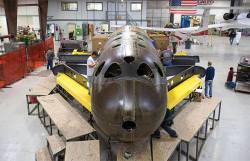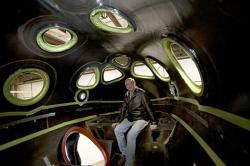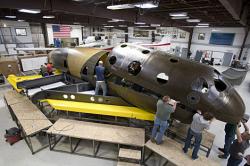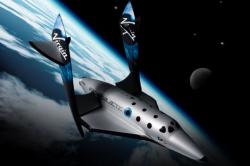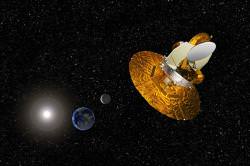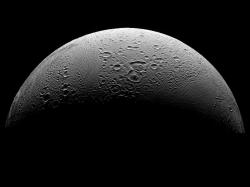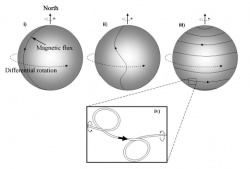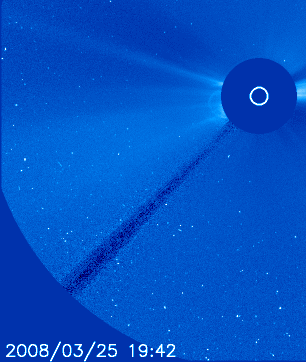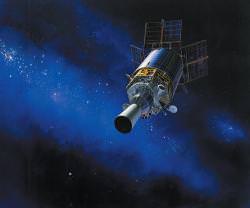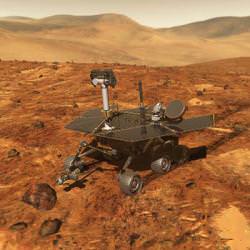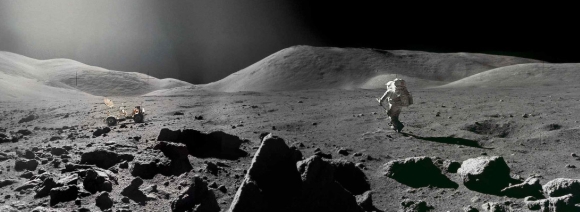In this exciting but challenging period of space exploration, the time is fast approaching for serious design concepts for the first habitats that will be built on the lunar landscape. In previous articles, we have examined the hazards associated with such an endeavor, we have looked at the structures available to us, we have even detailed a particular hangar-like structure that might use locally mined materials. Now, we look into the possible infrastructure elements that will be needed to support a viable colony on the Moon. Florian Ruess, a structural engineer who is working on the future of habitats in extreme environments, also took some time with the Universe Today to give his opinions on our future on lunar soil…
Imagine trying to build a structure on the surface of the Moon. Two of the biggest obstacles the first lunar settlers will come across are the very low gravity and the fine dust causing all sorts of construction issues. Although it seems likely that the first habitats will be built by automated processes before we even set foot on the moon, fabrication of a settlement infrastructure will be of primary concern to engineers so construction can be made as efficient as possible.
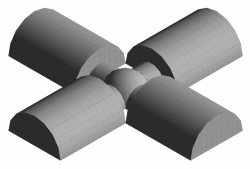
Infrastructure will be one of the most important factors concerning mission planners. How will building materials be fabricated? How will the material be supplied to construction workers? How will precious water and food be supplied to the fledgling lunar colony? Can supply vehicles go from A to B with little effort?
Historic examples of the effectiveness of efficient transportation infrastructure can be seen in the coalescence of cities around rivers (traditionally the quickest way to transport people and material around a country). Canals were instrumental in bringing cities to life during the Industrial Revolution in the UK in the late 18th century. As railway lines linked the East and West of North America in the last half of the 19th century, acceleration in population growth was experienced by people uprooting and “homesteading” the new, accessible farmlands. Over the last 50 years, the “Southern California freeway effect” is responsible for the proliferation of gas stations, restaurants, shops, followed by residential areas for workers – eventually, whole towns and cities are based around the ease of access for transportation.
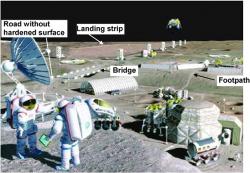
Future settlement of the Moon and Mars will most likely be based on a similar principle; the success of a lunar settlement will heavily depend on the efficiency of the transport structure.
It seems likely that most transportation around the Moon will depend on wheeled methods, following from terrestrial vehicles and tried and tested “Moon buggies” from the Apollo missions in the 1960s and ’70s. There are some significant drawbacks, however. Addressing this issue, Florian Ruess, structural engineer and collaborator with Haym Benaroya (whose publication this article is based) point out some problems with this mode of transport:
“For any mission there will always be the need for individual transportation and the obvious solution is some wheeled vehicle. But there are a couple of serious issues with this solution:
- Reduced traction. 1/6 gravity and the lunar soil make traction a problem just like [the Mars Exploration Rovers] Spirit and Opportunity on Mars one can get stuck easily or need to much power to get around.
- Dust. Apollo experience shows that a lot of dust is levitated by wheeled vehicles. This dust is hazardous to machines and humans when breathed in.”
– Florian Ruess (private communication)
So traveling around in a modified “dune buggy” might not be the answer for an established Moonbase, some form of road infrastructure would be needed if wheeled transportation is used.
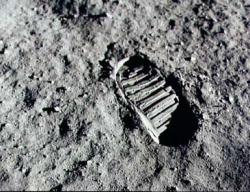
Disturbing dust on the lunar surface is far from being a minor problem. From NASA’s experience with the Apollo missions, by far the biggest contributor to dust generation was the takeoff and landing of lunar modules. 50% of the regolith is smaller than fine sand and approximately 20% is smaller than the “dusty” 0.02mm that preserved the Neil Armstrong’s first boot prints. It is this very fine component of the regolith that can cause a host of mechanical and health problems:
- Vision impairment
- Incorrect instrument readings
- Dust coating
- Loss of traction
- Clogging of mechanisms
- Abrasion
- Thermal control problems
- Seal failures
- Inhalation
It, therefore, seems obvious that dust creation should be kept to the bare minimum as this factor could be a severe hindrance to the infrastructure of the settlement.
Roads are would be the perfect answer to the new lunar colony. They would provide wheeled vehicles with the much-needed traction (thus having a knock-on effect with the fuel efficiency of the vehicle) and may significantly reduce the amount of dust suspension, especially if the road surface is raised above the surrounding regolith. Roads, however, have their drawbacks. They are enormously costly and may be very difficult to build. Fusing regolith to form a tough surface may be an answer, but as pointed out by Ruess, “…this requires enormous energies, which cannot be provided by solar power alone.” So an alternate form of energy would be required to perform such a construction.

Although road construction would be highly desirable, it may not be possible, at least in the early stages of lunar settlement development. One emerging development in alternative space transportation is the vertical take-off and landing method, but as previously stated, rocket-powered take-off and landing produce vast amounts of dust. But should there be multiple bases on the Moon, this might be a possibility, “…a lot of people recommend different solutions for routes that will be used frequently like getting from the landing pad to the settlement or from one settlement to the next,” Ruess adds.
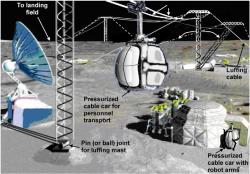
Another solution is an established form of transportation. Totally avoiding contact with the surface, thus cutting down on dust and avoiding obstacles, a lunar cable car might be a viable possibility. It seems likely that such a cable car transportation network would be highly effective. “Very large spans will be possible on the Moon and therefore infrastructure cost not exorbitant,” Ruess points out. This possibility is being seriously considered by lunar settlement planners.
Looking back on the previous articles in the series, Florian Ruess comments on whether lunar bases can be mobile and points out some of the severe difficulties facing settlement planners if locally mined materials are to be used:
“I am not a big fan of mobile bases. Such a system that includes power generation, communications and especially long-term meteoroid and radiation protection does not seem feasible to me. But the wheeled vehicles could be pressurized designs capable of serving several-day-long science missions. This would be a good solution to expand the capabilities of a permanent base.
“Local materials are a crucial yet difficult issue. My research so far has shown that only after a certain presence has been established and experience with lunar issues and materials has been gained we would be in a position to dare and build habitats from local materials. Certainly not before humans set foot on the Moon. And please forget about the much-cited lunar concrete! There are so many showstoppers for this imaginary material that I don’t even want to start mentioning them. The only early local material application I see is meteoroid and radiation protection using regolith as shielding material.”
“Building a Moon Base” is based on research by Haym Benaroya and Leonhard Bernold (“Engineering of lunar bases“)
Plus an exclusive interview with Florian Ruess, extreme habitat structural engineer and founder of Habitats for Extreme Environments – HE2
-Florian Ruess, private communication.
Many thanks to Florian Ruess for his time in contributing to this article. For further information about his work and extreme environment habitat designs, visit his website at HE-squared.com.
For more information about the future of lunar settlement, check out the Moon Society and the collaborative resource, Lunarpedia.

